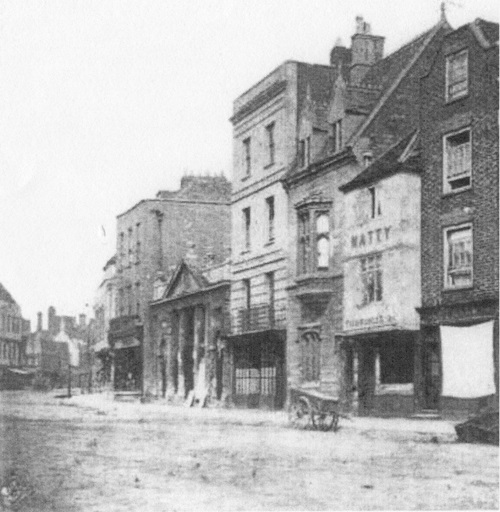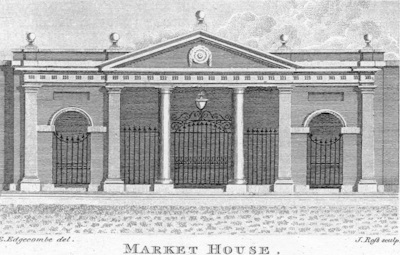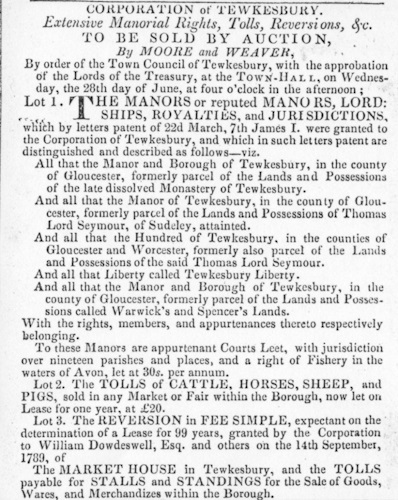Market House
on the site of today’s Methodist Chapel. Click Image
to Expand
Tewkesbury has been a market town from at least the thirteenth century, when the Earls of Gloucester granted to the Burgesses of the town, the right to levy tolls on goods passing through the town. These rights were first the subject of a Royal Charter from Edward III in 1337[1], which confirmed the earlier charters. The situation remained unchanged until the Charter of Elizabeth I granted in 1574.[2] Under the terms of this Charter, the town was incorporated as a free Borough, consisting of Bailiffs, Burgesses and Commonality. For practical purposes the Charter ordered that government of the town should be in the hands of the Bailiffs and twelve burgesses.
The Charter stipulated that markets should be held on Wednesdays and Saturdays, and that tolls on goods sold in the markets should be levied and collected by the Bailiffs, acting in their capacity as Clerks of the Market. These rights were again confirmed by Royal Charters granted by James I in 1605 and 1609, by James II in 1686 and William III in 1696.
The weekly markets were held in various parts of the town, but principally in the Tolsey, which stood at the junction of the three principal streets, the Cross. The area, around the Cross in the mid eighteenth century, looked much different from the scene today. The layout of the houses and roads made the turning from Church Street into the High Street, narrow and difficult for carts and coaches to negotiate.[3] In addition the Common Council were increasingly concerned at the state of the town on market days. Cattle, brought to market in the town, inevitably left behind a smelly mess on the roads, which were largely unpaved.
In 1772, the Common Council had passed a resolution that it would be desirable if a new Tolsey were to be built on the existing site at the Cross. Nothing was done until 1785, when the Council received a notification from Sir William Codrington, then the Member of Parliament, that he was “desirous and ready at the expense of £1,000, to erect and complete a Town Hall for transacting the public business of this Borough”. [4]
The Council, on receiving this offer, quickly rescinded the 1772 resolution and went ahead with clearing a site in the High Street and replaced it with the present Town Hall, which was completed in 1788. At that time there was an open space left in front of the Town Hall, which in 1857 was enclosed to form the present day Corn Exchange.
to Expand
With the area cleared there was room for a purpose-built Market House to be erected, but the Council were not able to finance such a project. The solution decided upon was to put the Market Tolls, payable under the Royal Charter, out to private enterprise, on a 99 year lease. On 16 September 1789, the Borough Chamberlain, John Pitt, was able to report that in the name of the Council, he had contracted with twenty people for the lease of the property and all the rights of Toll of stalls. The lease required a payment of £375 and an annual rent of 6s.8d. (33p). The lease also required the erection of the Market Hall at no expense to the Council and the reversion of the tolls and the new building to the Council in 1878. The Council also approved the making of rules for the management of the Market House.[7]
The twenty original investors in the Market House were:-[8]
William Dowdeswell, of the Junior Temple, London; Henry Fowke, Gentleman; The Rev James Tattersall, Clerk; The Rev Francis Mines, Clerk; John Terrett, Surgeon and Apothecary; Thomas Woollams, Hosier; Omwell Lloyd, Mercer; William Dillon, Surgeon and Apothecary; Andrew Woollams, Haberdasher; George Vernon, Distiller; Charles Embury, Distiller; William Thomas, Grocer; Ann Waring, Widow; Thomas Barnes, Ironmonger; John Barnes, Hosier; Thomas Grazebrook, Glazier; John Millard, Maltster; Philip Godsall of Longacre in the City of Westminster; Edwin Jeynes of the City of Gloucester and Henry Prior the younger, of Kemerton.
The cost of the site, the erection of the Market House and the provision of fixtures and fittings cost about £1,400.[9] Each of the entrepreneurs contributed £70. James Bennett commented that “considerable sums of money had been expended on alteration and reparations, but the shareholders have had no cause to regret their speculation”.[10] From the Market House Rules which were made by the Town Council in 1789,[11] we can glean a picture of the inside of the building. On either side of the entrance from Church Street stalls were erected for the sale of poultry, eggs, butter and roasting pigs. Moving down the Hall, one came to two ranges of stalls, devoted to the sale of earthenware, glass, china and pottery. Behind these stalls were a further two ranges of stalls for use by butchers as a flesh market. Then came two ranges of stalls for the sale of vegetables; these were interspersed with stalls for the sale of fish and seafood. Right at the back of the premises, adjacent to the banks of the River Swilgate, there were stalls and pens for the sale of live pigs.
For each type of merchandise, a toll was imposed that reflected the relative value of the goods on the stalls; for example, the sale of a goose, turkey or roasting pig attracted a toll of one penny, whilst for a pen for the sale of four pigs, the toll was sixpence.
For the first thirty years of its existence, the shareholders enjoyed a reasonable return on their investment and shares in the Market House changed hands at sums up to £94. In some years, the shareholders sold the tolls at auction, and sometimes retained them, presumably when they needed money to effect repairs or improvements. By 1830, many of the shares had found their way into the hands of the auctioneers.
In 1835, the government of the town was changed by the Municipal Corporations Act.[12] The old Common Council was swept away, to be replaced by a Council of elected members and Aldermen appointed by the Councillors. The first free election of the Council resulted in the election of an all Whig (Liberal) Council. The new Council inherited a dreadful financial legacy. Income from tolls had been the principal source of income for the Council and this had almost disappeared. In a series of legal actions, the old Council had successfully defended its right to collect the tolls, but the legal costs had bankrupted the Council. Most of the Council’s property was mortgaged to the town’s Member of Parliament, J.E. Dowdeswell, in return for the loan of £2,000.[13]
the Market House in 1837Click Image
to Expand
- The Manorial Rights
- The Tolls of Cattle
- The reversion of the Market House and Tolls of stallage, and
- The reversion in the houses in Gloucester Row”[14]
The Council accepted the recommendation and “ordered that it be referred to Mr John Moore and Mr Winterbotham to appoint the time and make the necessary arrangements for the sale”. On 5 July 1837, the Town Clerk reported to the Council that the reversion on the Market House and the Tolls of Stallage had been sold to Mr Anthony Sproule for the sum of £120.[15]
Anthony Sproule was a solicitor in partnership with John Moore, but in the purchase of the Market House and tolls he was acting as the agent of William Moore, who was a wine merchant. In a deed made on 8 December 1837, the shareholders acknowledged that Sproule and Moore owned the Market House, subject to their rights as shareholders to receive dividends. Over the next few years, control of the Market House increasingly fell into the hands of the Moore family, who bought the shares as the owners disposed of them at auction.
It is easy to imagine the scene in the Market House during the sale hours, but other events were held there which are worthy of note. The notebooks of the Moore firm of Auctioneers[16] reveal that the Market House was often used for auction sales. All too often goods were sold in the Market House, which had been taken by landlords under distress when rents were unpaid.
The Coronation of the young Queen Victoria was celebrated in the Market House on 28 June 1838. The Town Council raised subscriptions from amongst the townspeople.[17] Tickets were issued to the poor inhabitants, which could be redeemed at any of the following butchers, 1838"Messrs. G. Bishop, S. Bishop, J. Westbury, J.Gannaway, B. Dobbins, W. Townsend, T. Boulter and J. Banks. The children of the various Sunday Schools assembled in their rooms and processed to the Market House, where a dinner of “Roast Beef and Plum Pudding” was provided.[18]
From
the point of view of the shareholders, it was unfortunate that the Town Council
did not part with the tolls on cattle and corn, since this enabled the growth
of a cattle market from 1840-50. The result was that business in the Market
House declined such that in 1868, the shareholders decided to sell their
property. Two lots were submitted for auction at the Hop Pole on 7 October 1868.
What happened during the next few years to effect a sale of the Market House is not documented. However, on 6 August 1872, the Market House the tolls and the Weighing Machine outside the Hall, were sold to the building partnership of Thomas Collins and William Cullis.[20] Collins and Cullis had no desire to operate a market and they used the building as a timber store. Both of the partners were prominent members of the Wesleyan Chapel in Tolsey Lane: Collins was the Senior Circuit Steward. From the records of the Wesleyans as early as 1864, it was clear that they were anxious to build a new Chapel since they had outgrown the Tolsey Lane Chapel, which they had used since 1814. In retrospect, it appears that Collins had in mind that the Market House could be replaced by a new Chapel and so he bought it and held it until the Wesleyans had raised the purchase money.
The ownership of the Market House, together with the tolls and weighing machine, passed to the Wesleyan Trustees on 13 November 1875. During the next few months the Wesleyans went about raising the money with which to build a new Chapel. By September 1876, they had decided that the site of the Market House had to be completely razed to the ground and an advertisement was placed in the Tewkesbury Register offering three lots to be sold by tender. Lot 1 comprised “all the materials from the buildings on the site, including the pavements, stone steps, division walls, the roofs with timber, slates, lead guttering, spots and conductors, the stone front, with pillars, gates and all and every material comprised within the limits of the north, south and east boundary walls, with the copings and the iron railings on the east boundary”[21]
Lot 2 was for the Weighing Bridge and its appliances; the purchaser of this lot was required to fill up the pit and make good the street pavement. Lot 3 was for the Borough tolls, with all their rights and perquisites.
The sale of materials raised a total of £57.10s.0d. (£57.50p) towards the new building, but it is interesting to speculate that some of the old Market House frontage was reused for the Chapel. The line drawings of the Market House that appeared in James Bennett’s History of Tewkesbury, and in William Dyde’s History and Antiquaries of Tewkesbury, both show the frontage had some stone pillars. This is confirmed by an early photograph in the Gloucestershire Records Office collection, dating from about 1870, in which the situation of the central pillars looks very much like the gateposts of the Methodist Church that we see today.[22] The top sections of the central pillars could well have been reused for the pillars which mark the boundaries of the Chapel garden adjacent to the ‘Burger Star’ and an estate agent’s offices.
The Town Council feared that if the toll rights fell into private hands, they might be used to inhibit trade in the town. They were not keen to acquire the Weighing Bridge, since they believed that there were sufficient weighbridges elsewhere in the town. After much debate, they decided that it would be sensible for both lots to be purchased in the name of the Board of Health and that body paid the grand sum of £65 for them.[23]
There was to be no replacement market hall in the town, and the Town Council do not appear to have imposed tolls again on livestock coming in to the town. However, the tolls do enable the Council to control the holding of the twice weekly market which now takes place on the Spring Gardens car park. The organisation of the market is leased to a private company, who pay a considerable rent to the Council. To walk around this thriving market, few people realise that they are taking part in an event which has been held in the town for over 800 years.
References
- James Bennett, History of Tewkesbury, p322.
- Bennett, p378.
- Bennett, p219.
- Gloucestershire Records Office (GRO) – TBR A/1/8.
- 26 George III 1786.
- GRO – TBR A/1/8.
- GRO – TBR A/1/8.
- Indenture dated 15 September, 1789 with the deeds of Tewkesbury Methodist Church deposited at GRO. All, except Dowdeswell, were based in Tewkesbury.
- Worth around £75,000 today (Editor).
- Bennett p 222.
- GRO – TBR A/1/8.
- 5&6 Wilm. IV Chapter 76.
- Today worth about £93,000 (Editor).
- The present day Abbey Terrace.
- GRO – TBR A 1/9.
- GRO – D2080.
- Gloucestershire Collection at Gloucester Library – RX302.7.
- James Bennett, Yearly Register & Magazine, Vol. I, p372.
- Tewkesbury Register 3 & 10 November 1868.
- Deeds of Tewkesbury Methodist Church at GRO D2599.
- Register, 22 April 1876.
- GRO: GPS 329/9.
- Register 8 July, 9 September and 23 September 1876. Worth around £2,900 today (Editor).





Comments